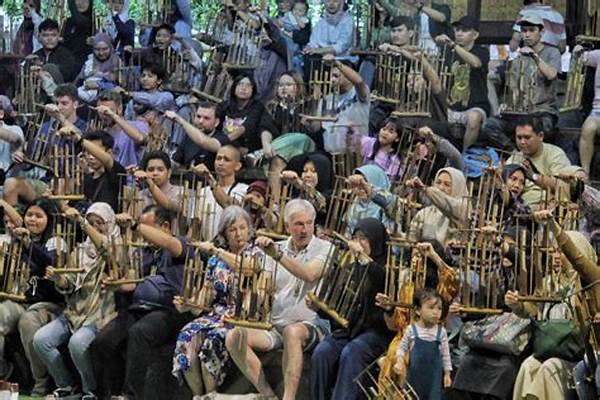When you think of an Indonesian orchestral instrument that combines tradition with a global appeal, the angklung stands out as a clear contender. Its unique and melodious sound can transform any orchestra into a harmonious ensemble, captivating audiences around the globe. But what makes these angklung orchestras so special that they are revered in concert halls from Paris to New York? It’s time to dive into the melodic world of angklung and discover its unparalleled cultural significance.
Read More : Chinese Traditional Music Instrument Revitalized In Fusion Jazz Ensembles
Angklung, originating from West Java, Indonesia, is not just an instrument; it’s a cultural ambassador, showcasing the rich heritage and artistry of the Indonesian people. This bamboo instrument, played by shaking to produce a note, requires collective cooperation, making it a perfect metaphor for harmony and unity. It’s no wonder that angklung orchestras are making their mark worldwide, with each performance a testament to the beauty and inclusivity of Indonesian culture.
The Rise of Angklung Orchestras
There’s a growing fascination with angklung orchestras, and it’s not just because of the music. Imagine attending a concert where each note and rhythm reflects centuries-old traditions, yet feels as fresh and relevant as any contemporary beat. This is the magic of angklung orchestras. They’ve transformed from local performances in Indonesian villages to grand stages internationally, becoming a global cultural phenomenon.
These orchestras are often filled with enthusiastic musicians who bring humor and joy to their performances. From humorous interactions between players to engaging narratives about the origins of the music, they ensure each show is not just a concert but an experience. Some musicians even offer workshops for audiences to learn and play the instrument themselves, further connecting global communities through music.
Evolution and Global Influence of Angklung
Angklung as a Universal Language
Angklung has evolved into a universal language that transcends cultural and linguistic barriers. The orchestras that play this instrument showcase not only the dexterity required to handle bamboo tubes but also the evolution of a traditional craft meeting modern techniques.
What makes angklung orchestras stand out is their adaptability. Whether it’s a rendition of Beethoven’s symphonies or pop culture hits, angklung orchestras have proved versatile. This adaptability makes angklung a desirable instrument for collaborations in various music genres internationally. The engaging sound of the angklung has won over audiences who might have no prior knowledge of Indonesian culture but are captivated by the instrument’s compelling and soulful resonance.
Notable Performances Around the World
From the bustling streets of Tokyo to the majestic theatres of New York, angklung orchestras have left an indelible mark. Highlights include performances at UNESCO events, where the angklung is celebrated as an Intangible Cultural Heritage of Humanity. These performances are not just about music; they are cultural exchanges, often accompanied by traditional Indonesian dances and attire, which offer audiences a full spectrum of Indonesia’s artistic prowess.
The Future of Angklung Orchestras
Looking forward, angklung orchestras are poised to expand their global reach even further. With increasing international collaborations and more exposure in global media, the best instrument Indonesia angklung orchestras are set to become even more prominent. Music educators worldwide are beginning to incorporate angklung into their curriculums, introducing a new generation to its enchanting sound and cultural relevance.
Why Angklung Orchestras Are Winning Hearts
Testimonials from the Audience
Witnessing an angklung orchestra in action is a feast for the senses. Audiences worldwide have praised the orchestras for their serene yet exhilarating performances. As one concert-goer in Paris noted, “I came for the music, but I stayed for the journey through Indonesian culture.” This sentiment is echoed in testimonials from enthusiasts across the globe, highlighting how deeply the music resonates on an emotional level.
Read More : Recommended Portable Drum Instruments With Bluetooth Features
Expert Opinions and Research
Musicologists and cultural scholars have taken an interest in angklung, studying its impact and reflecting on its ability to bridge cultures. Research indicates that participating in or listening to angklung orchestras can foster a greater understanding and appreciation for multiculturalism, making these performances not just entertaining but educational as well.
Key Highlights of Angklung Orchestras
Challenges and Aspirations
While the journey of angklung orchestras is inspiring, it’s not without its challenges. Financial support for maintaining instruments and organizing international tours is crucial. Moreover, musicians often need to balance traditional elements with innovative expressions to stay relevant in the modern music world.
Nonetheless, the aspirations of these orchestras are set high. They aim to not just entertain but also educate and inspire future generations of musicians and audiences alike about the rich tapestry of Indonesian culture through angklung.
Conclusion: A Harmony of Cultures
The story of the best instrument Indonesia angklung orchestras performing worldwide is one of rhythmic harmony transcending borders. It’s a narrative not only of captivating music but also of cultural connections and shared humanity. These orchestras are not merely performing; they are continuing a legacy, one that invites the world to listen, learn, and play along.
Celebrating a Global Phenomenon
As angklung continues its melodic journey across stages worldwide, it invites everyone to partake in its story. Whether you’re a music enthusiast, a cultural explorer, or someone intrigued by new experiences, angklung orchestras offer something luxurious yet accessible. They’re a compelling call to action for anyone looking to explore the symphonic unity of global cultures—one bamboo tube shake at a time.
